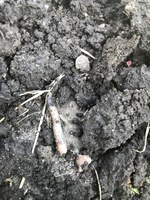Dakota Gardener: Growing Soil Organic Matter
(Click an image below to view a high-resolution image that can be downloaded)
By Carrie Knutson, Horticulture Agent
NDSU Extension - Grand Forks County
Frequently as gardeners we concentrate efforts on our plants, focusing on what varieties will give us the best tasting produce or a beautiful landscape. However, I encourage all gardeners to “dig” a little deeper and concentrate some of our efforts on the soil.
In the spirit of getting our hands dirty, let’s dig into carbon and soil organic matter.
What is carbon? Carbon gets a reputation as being bad for us and the environment. While that is true for increasing levels of carbon dioxide in our atmosphere, carbon is necessary as a building block for life on earth.
Carbon is used to build cell tissues and for metabolic (energy-producing) reactions. It is used in cell membranes, is a component of fats and waxes and is in carbohydrates which make sugars and starches. Sugars can be connected to form larger compounds like cellulose and lignin which give plants their sturdy structure. Plants use starch to store energy for future needs. Squash and potatoes are great examples of starchy vegetables.
Once carbon from plants or animals has been incorporated into the soil by human activities (like tillage), by animal movement (like earthworms) or by plant roots dying, it becomes soil organic matter. There are two main pools of soil organic matter: active and passive.
The active pool is around for the short term and serves as a food source for soil microbes and other organisms that live in the soil. It is in high demand and when it is consumed carbon dioxide is released into the atmosphere. This decomposition process also releases nutrients, like nitrogen, into the soil.
The passive pool is around for the long term. It is chemically transformed by passing through the stomachs of microbes. The more material that passes through microbes, the more passive organic matter is stored in the soil. This organic matter is bound to soil particles and referred to as mineral associated organic matter (MAOM) and is protected by soil aggregates. Soil aggregates occur when individual soil particles are bound together. Aggregates occur naturally in healthy soils.
Active and passive soil organic matter pools are important for our gardens. Soil organic matter increases the nutrient and water holding capacity of our soil, protects the soil from erosion and crusting, and provides an ecosystem service by cleaning the soil and water.
The best way to grow soil organic matter and microbes in your garden is to simply do less work. Because microbes live in soil aggregates and soil organic matter is stored there, keeping soil structure intact is essential. Limiting soil disruption in your garden using reduced till or no-till methods, preventing soil erosion by using mulch or cover crops, adding plant residues like compost or leaving disease free plant residue on top of the soil and cutting plants off at the soil surface to remove them will help preserve soil and soil organic matter in your garden.
If you would like to learn more about soil organic matter, search for the publication “Soil Organic Matter Does Matter” by Caley Gasch, NDSU School of Natural Resource Sciences assistant professor, and Jodi DeJong-Hughes, University of Minnesota Extension educator, water resources.
Because of the benefits of having soil rich in organic matter, I encourage you to start thinking about adding microbes and soil organic matter to your list of things to grow this season. Happy gardening!
NDSU Agriculture Communication – April 19, 2022
Source: Carrie Knutson, 701-780-8229, carrie.knutson@ndsu.edu
Editor: Kelli Anderson, 701-231-6136, kelli.c.anderson@ndsu.edu




